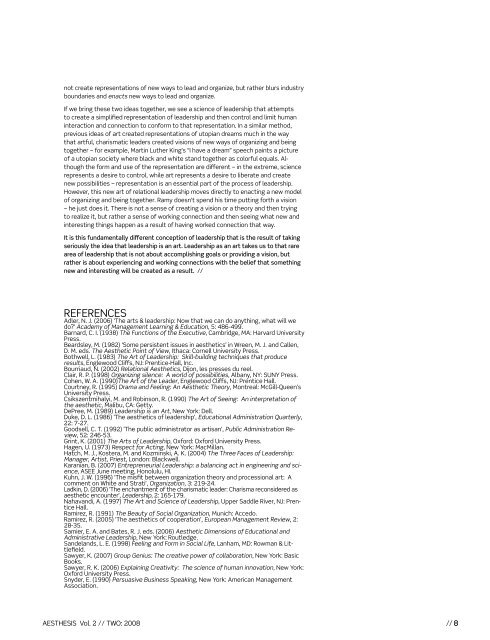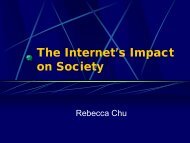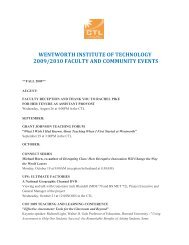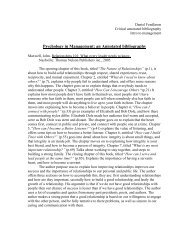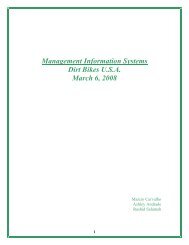International Journal of Art and Aesthetics in ... - DigitalFilm Tree
International Journal of Art and Aesthetics in ... - DigitalFilm Tree
International Journal of Art and Aesthetics in ... - DigitalFilm Tree
You also want an ePaper? Increase the reach of your titles
YUMPU automatically turns print PDFs into web optimized ePapers that Google loves.
not create representations <strong>of</strong> new ways to lead <strong>and</strong> organize, but rather blurs <strong>in</strong>dustry<br />
boundaries <strong>and</strong> enacts new ways to lead <strong>and</strong> organize.<br />
If we br<strong>in</strong>g these two ideas together, we see a science <strong>of</strong> leadership that attempts<br />
to create a simplified representation <strong>of</strong> leadership <strong>and</strong> then control <strong>and</strong> limit human<br />
<strong>in</strong>teraction <strong>and</strong> connection to conform to that representation. In a similar method,<br />
previous ideas <strong>of</strong> art created representations <strong>of</strong> utopian dreams much <strong>in</strong> the way<br />
that artful, charismatic leaders created visions <strong>of</strong> new ways <strong>of</strong> organiz<strong>in</strong>g <strong>and</strong> be<strong>in</strong>g<br />
together – for example, Mart<strong>in</strong> Luther K<strong>in</strong>g’s “I have a dream” speech pa<strong>in</strong>ts a picture<br />
<strong>of</strong> a utopian society where black <strong>and</strong> white st<strong>and</strong> together as colorful equals. Although<br />
the form <strong>and</strong> use <strong>of</strong> the representation are different – <strong>in</strong> the extreme, science<br />
represents a desire to control, while art represents a desire to liberate <strong>and</strong> create<br />
new possibilities – representation is an essential part <strong>of</strong> the process <strong>of</strong> leadership.<br />
However, this new art <strong>of</strong> relational leadership moves directly to enact<strong>in</strong>g a new model<br />
<strong>of</strong> organiz<strong>in</strong>g <strong>and</strong> be<strong>in</strong>g together. Ramy doesn’t spend his time putt<strong>in</strong>g forth a vision<br />
– he just does it. there is not a sense <strong>of</strong> creat<strong>in</strong>g a vision or a theory <strong>and</strong> then try<strong>in</strong>g<br />
to realize it, but rather a sense <strong>of</strong> work<strong>in</strong>g connection <strong>and</strong> then see<strong>in</strong>g what new <strong>and</strong><br />
<strong>in</strong>terest<strong>in</strong>g th<strong>in</strong>gs happen as a result <strong>of</strong> hav<strong>in</strong>g worked connection that way.<br />
it is this fundamentally different conception <strong>of</strong> leadership that is the result <strong>of</strong> tak<strong>in</strong>g<br />
seriously the idea that leadership is an art. leadership as an art takes us to that rare<br />
area <strong>of</strong> leadership that is not about accomplish<strong>in</strong>g goals or provid<strong>in</strong>g a vision, but<br />
rather is about experienc<strong>in</strong>g <strong>and</strong> work<strong>in</strong>g connections with the belief that someth<strong>in</strong>g<br />
new <strong>and</strong> <strong>in</strong>terest<strong>in</strong>g will be created as a result. //<br />
ReFeRences<br />
Adler, n. J. (2006) ‘the arts & leadership: now that we can do anyth<strong>in</strong>g, what will we<br />
do?’ Academy <strong>of</strong> Management learn<strong>in</strong>g & education, 5: 486-499.<br />
Barnard, c. I. (1938) the Functions <strong>of</strong> the executive, cambridge, MA: Harvard University<br />
Press.<br />
Beardsley, M. (1982) ‘some persistent issues <strong>in</strong> aesthetics’ <strong>in</strong> Wreen, M. J. <strong>and</strong> callen,<br />
D. M. eds. the Aesthetic po<strong>in</strong>t <strong>of</strong> View, Ithaca: cornell University Press.<br />
Bothwell, L. (1983) the <strong>Art</strong> <strong>of</strong> leadership: skill-build<strong>in</strong>g techniques that produce<br />
results, englewood cliffs, nJ: Prentice-Hall, Inc.<br />
Bourriaud, n. (2002) relational <strong>Aesthetics</strong>, Dijon, les presses du reel.<br />
clair, R. P. (1998) organiz<strong>in</strong>g silence: A world <strong>of</strong> possibilities, Albany, nY: sUnY Press.<br />
cohen, W. A. (1990)the <strong>Art</strong> <strong>of</strong> the leader, englewood cliffs, nJ: Prentice Hall.<br />
courtney, R. (1995) Drama <strong>and</strong> Feel<strong>in</strong>g: An Aesthetic theory, Montreal: McGill-Queen’s<br />
University Press.<br />
csikszentmihalyi, M. <strong>and</strong> Rob<strong>in</strong>son, R. (1990) the <strong>Art</strong> <strong>of</strong> see<strong>in</strong>g: An <strong>in</strong>terpretation <strong>of</strong><br />
the aesthetic, Malibu, cA: Getty.<br />
DePree, M. (1989) leadership is an <strong>Art</strong>, new York: Dell.<br />
Duke, D. L. (1986) ‘the aesthetics <strong>of</strong> leadership’, educational Adm<strong>in</strong>istration Quarterly,<br />
22: 7-27.<br />
Goodsell, c. t. (1992) ‘the public adm<strong>in</strong>istrator as artisan’, public Adm<strong>in</strong>istration review,<br />
52: 246-53.<br />
Gr<strong>in</strong>t, K. (2001) the <strong>Art</strong>s <strong>of</strong> leadership, oxford: oxford University Press.<br />
Hagen, U. (1973) respect for Act<strong>in</strong>g, new York: MacMillan.<br />
Hatch, M. J., Kostera, M. <strong>and</strong> Kozm<strong>in</strong>ski, A. K. (2004) the three Faces <strong>of</strong> leadership:<br />
Manager, <strong>Art</strong>ist, priest, London: Blackwell.<br />
Karanian, B. (2007) entrepreneurial leadership: a balanc<strong>in</strong>g act <strong>in</strong> eng<strong>in</strong>eer<strong>in</strong>g <strong>and</strong> science,<br />
Asee June meet<strong>in</strong>g, Honolulu, HI.<br />
Kuhn, J. W. (1996) ‘the misfit between organization theory <strong>and</strong> processional art: A<br />
comment on White <strong>and</strong> strati’, organization, 3: 219-24.<br />
Ladk<strong>in</strong>, D. (2006) ‘the enchantment <strong>of</strong> the charismatic leader: charisma reconsidered as<br />
aesthetic encounter’, leadership, 2: 165-179.<br />
nahav<strong>and</strong>i, A. (1997) the <strong>Art</strong> <strong>and</strong> science <strong>of</strong> leadership, Upper saddle River, nJ: Prentice<br />
Hall.<br />
Ramirez, R. (1991) the Beauty <strong>of</strong> social organization, Munich: Accedo.<br />
Ramirez, R. (2005) ‘the aesthetics <strong>of</strong> cooperation’, european Management review, 2:<br />
28-35.<br />
samier, e. A. <strong>and</strong> Bates, R. J. eds. (2006) Aesthetic Dimensions <strong>of</strong> educational <strong>and</strong><br />
Adm<strong>in</strong>istrative leadership, new York: Routledge.<br />
s<strong>and</strong>el<strong>and</strong>s, L. e. (1998) Feel<strong>in</strong>g <strong>and</strong> Form <strong>in</strong> social life, Lanham, MD: Rowman & Littlefield.<br />
sawyer, K. (2007) Group Genius: the creative power <strong>of</strong> collaboration, new York: Basic<br />
Books.<br />
sawyer, R. K. (2006) expla<strong>in</strong><strong>in</strong>g Creativity: the science <strong>of</strong> human <strong>in</strong>novation, new York:<br />
oxford University Press.<br />
snyder, e. (1990) persuasive Bus<strong>in</strong>ess speak<strong>in</strong>g, new York: American Management<br />
Association.<br />
AestHesIs Vol. 2 // tWo: 2008 // 8


